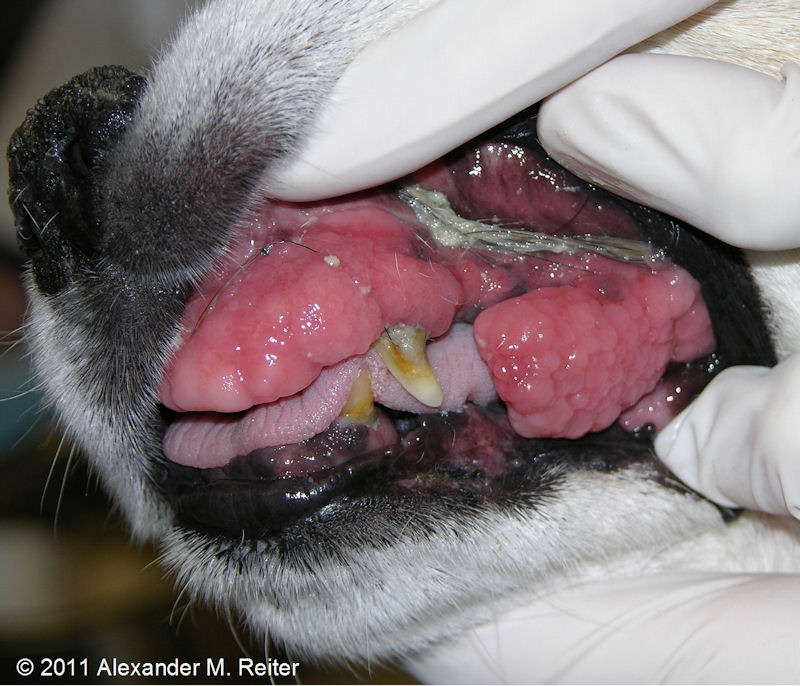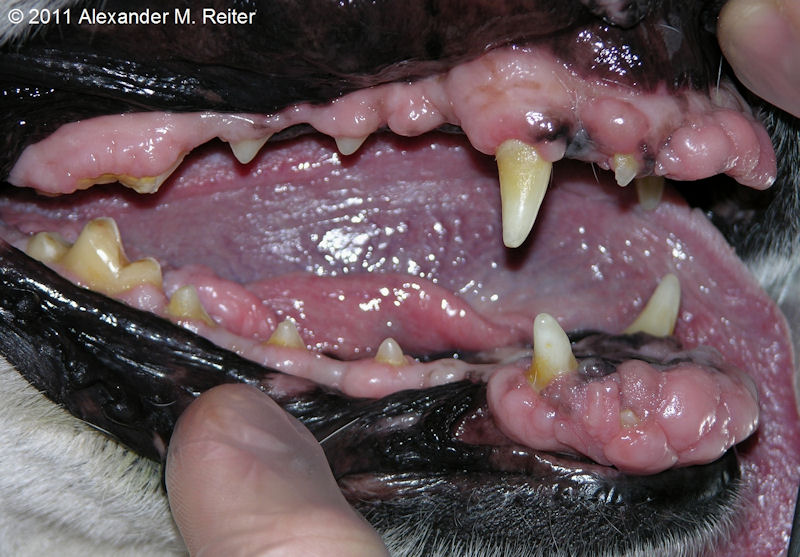Gingival enlargement
Synonym(s): Hyperplastic gingivitis; Gingival hyperplasia; Epulis
Introduction
- Gingival enlargment is a clinical term, referring to an increase in the size or thickness of gingiva. Determining a benign or malignant underlying cause for gingival enlargement requires biopsy and histopathological examination of sampled tissues.
- Epulis is a non-specific term referring to a local, exophytic growth on the gingiva; it should not be used without the addition of adjectives that give the epulis a distinctive pathologic entity.
- Gingival hyperplasia is a histological (not clinical) term, referring to an abnormal increase in the number of normal cells in a normal arrangement.
- Gingivectomy and gingivoplasty Gingivectomy and gingivoplasty are surgical procedures designed to remove excess gingiva and to restore its physiological contours.
Presenting signs
- Excessive gingival tissue partially or totally covering one or more teeth.
- Gingival enlargement ranging from slight ballooning of the gingival margin or interdental papilla to sessile or pedunculated mass formation (which can be focal or generalized).
- Progression of gingival hyperplasia, cysts and benign tumors usually slow and painless, unless complicated by acute infection or trauma.
- Pseudopocket formation (with increased probing depth even in the absence of attachment loss) as a result of gingival enlargement in a vertical direction.
- Halitosis due to plaque accumulation in pseudopockets.
- Occasional bleeding or drooling of blood-tinged saliva from biting onto excess gingival tissue.
Breed/Species predisposition
- Brachycepahlic dogs such as Boxer Boxer.
- Great Dane Great Dane.
- Collie Collie - Rough.
- Doberman pinscher Dobermann.
- Dalmation Dalmatian.
Pathogenesis
Etiology
- Hereditary predisposition (familial tendency) for generalized gingival enlargement in brachycephalic dogs.
- Acute or chronic inflammatory reaction of the gingiva:
- Acute: gingivitis, periodontal abscess, inflammatory tooth resorption.
- Chronic: prolonged exposure to dental plaque; mouth breathing in humans with open bite.
- Drug-induced gingival hyperplasia:
- Anticonvulsants.
- Cyclosporine Ciclosporin

 .
. - Calcium channel blockers.
- Gingival enlargment due to systemic conditions, causing increased vascular permeability, gingival edema, and increased inflammatory response to dental plaque:
- Hormonal conditions (eg during pregnancy and puberty in humans; during adolescence and young age in cats: acromegaly).
- Nutritional disease (eg vitamin C deficiency in humans).
- Systemic diseases (eg leukemia and granulomatous diseases in humans and dogs).
- Benign tumors or tumor-like lesions of the gingiva Mouth: neoplasia Non neoplastic oral masses.
- Malignant tumors of gingiva Mouth: squamous cell carcinoma (gingival).
- False gingival enlargement, resulting from an increase in the size of the underlying osseous or dental tissues

 .
.
Pathophysiology
- In the case of inflammatory reaction of the gingiva:
- Plaque accumulation on teeth → inflammatory reaction of gingiva → gingival enlargement → pseudopockets formation → further debris and plaque accumulation in pseudopocket → continued gingivitis → change from aerobic gram-positive to anaerobic gram-negative bacterial flora → periodontal attachment loss → periodontitis Periodontitis.
- In the case of conditioned gingival enlargement (hormonal changes, vitamin D deficiency, etc):
- Systemic condition → increased vascular permeability → gingival edema → increased inflammatory response of gingiva to dental plaque → continuing as above.
- In the case of drug-induced gingival hyperplasia (independent of local inflammation):
- Drug administration → alteration of gingival tissue, including:
- Stimulation of connective tissue and epithelial cell proliferation.
- Prevention of apoptosis (programmed cell death).
- Upregulation of inflammatory cytokines.
- Drug administration → alteration of gingival tissue, including:
Diagnosis
Subscribe To View
This article is available to subscribers.
Try a free trial today or contact us for more information.
Treatment
Subscribe To View
This article is available to subscribers.
Try a free trial today or contact us for more information.
Prevention
Subscribe To View
This article is available to subscribers.
Try a free trial today or contact us for more information.
Outcomes
Subscribe To View
This article is available to subscribers.
Try a free trial today or contact us for more information.
Further Reading
Publications
Refereed papers
- Recent references from PubMed and VetMedResource.
- Lewis J R, Reiter A M (2005) Management of generalized gingival enlargement in a dog - Case report and review of the literature. J Vet Dent 22, 160-169 PubMed.